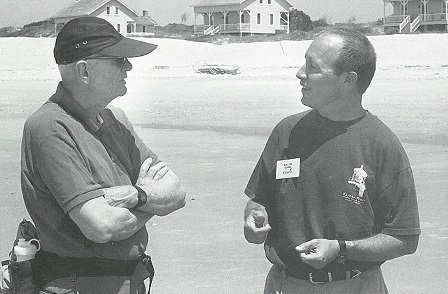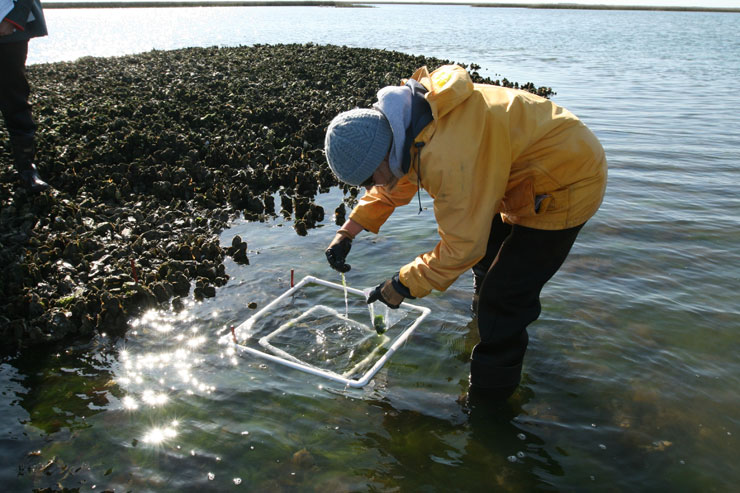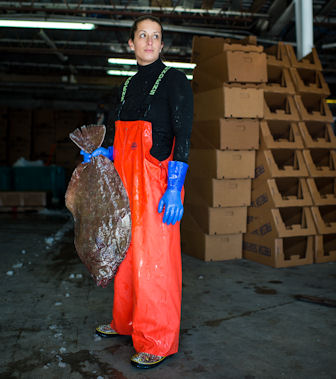SEA BASS POTS: Bigger Mesh May Yield Larger Fish

Tom Burgess starts to laugh as he slows the Barbara Lynne to turn it around.
“Did you see how many traps we went by?” he asks as he guides his boat back towards his buoys. “Usually, I have nothing to do but watch for the pots.”
This bright March morning, first mate Mike Avant is telling stories of his recent Costa Rica trip to Paul Rudershausen, a technician from North Carolina State University’s Center for Marine Sciences and Technologies (CMAST). The boat is in the federally managed waters of Onslow Bay, the shallower part of the Atlantic close to Sneads Ferry, where Burgress lives.
Burgess is working on an N.C. Fishery Resource Grant (FRG) to study the efficiency and effectiveness of different configurations of black sea bass pots. FRG is funded by the N.C. General Assembly and administered by North Carolina Sea Grant. Rudershausen and Scott Baker, a Sea Grant fisheries extension specialist, are helping with the study.
They are testing three types of pots: one made of 1.5-inch mesh with a 2-inch back panel; another made entirely of 2-inch mesh; and a third made entirely of 1.5-inch mesh. The first is the minimum mandatory pot required by the South Atlantic Fishery Management Council (SAFMC) that manages the black sea bass fishery in North Carolina. Burgess had to get a special permit from the National Marine Fisheries Service to use the full 1,5-inch pots that are smaller than the minimum pot requirement.
“We’ll break 10,000 today,” Rudershausen predicts, as he glances at the data from previous trips. Burgess and Avant have caught almost 9,400 black sea bass in the 12 research trips they have completed so far. This is their last trip.
As the boat approaches the orange and white buoys that mark the location of a pot, Avant reaches out with a long gaff and pulls in the line. Burgess runs the line through a mechanical wheel that retrieves the pot.
As the pot emerges from the water, Burgess guides it onto the side of the boat and sets it on its rebar-lined bottom. A few black sea bass are stuck in the square mesh, their gills spread wide. Burgess pries the fishes from the mesh and slides them back into the pot.
He carefully pivots the square-mesh pot on one corner, flips it upside down and opens the top. The sea bass flop out as Burgess shakes them into a green plastic bin.
Then Avant and Rudershausen get to work. Avant measures each fish and tosses back those that are less than 10 inches long. Rudershausen records all the fishes’ lengths and watches the movements of the sub-legal, or undersized, fish as they go overboard. He notes if they swim vigorously to the bottom or float at the surface, an indication of their health upon release.
After all 30 pots are retrieved and the Barbara Lynne is heading home, Rudershausen announces the total number of fish caught: 9,996.
“Really?” Burgess chuckles. “If I had more bait, we could go back and get more.”
Burgess’s FRG study is designed to measure and compare the effectiveness of each type of pot — he calls them traps — based on catch rate and discard mortality. He has three main tasks: determine if a certain pot type catches more legal sea bass; discover if a particular pot type catches more undersized sea bass; and compare the health of the released sub-legal sea bass from each pot type.
Burgess is comparing the selectivity of pots with 2-inch back panels to pots with 2-inch mesh. He also is using the pots with 1.5-inch mesh to estimate the number of sub-legal fish in the area. Because the smaller-mesh pots catch more undersized fish, Burgess can use the catch information as a survey of the sub-legal sea bass in Onslow Bay.
Very little is known about the life cycle of black sea bass. Burgess’s data might help the SAFMC develop a baseline population assessment for undersized sea bass.
Such information can be useful to both scientists and fishery managers. Rick DeVictor, the SAFMC’s environmental impact scientist, is looking forward to Burgess’s final report. The findings potentially could inform future SAFMC efforts in rebuilding the black sea bass population.
BLACK SEA BASS
“Sneads Ferry is the top producer of black sea bass in the South Atlantic,” says Burgess, who also is a member of the SAFMC snapper/grouper advisory panel. The six to eight sea bass fishers in his coastal community represent about 70 percent of the commercial black sea bass potters in North Carolina, which catches about 85 percent of commercial black sea bass landings within the South Atlantic region.
The SAFMC manages fish stocks in federal waters for North Carolina, South Carolina, Georgia and east Florida to Key West.
The bulk of the sea bass harvest occurs in federal waters that stretch from 3 to 200 miles offshore and are outside the state’s jurisdiction. Occasionally, the potters work in state-managed waters.
Black sea bass are found from Maine to Florida and into the Gulf of Mexico. Although the same species, black sea bass north and south of Cape Hatteras are managed differently. Sea bass north of Cape Hatteras are considered “viable” and are managed by the Mid-Atlantic Fishery Management Council.
The SAFMC manages the sea bass fishery south of Cape Hatteras, where Sneads Ferry is located. There, sea bass are “experiencing overfishing and are overfished,” two different, although similar-sounding, categories.
“Overfishing has to do with the fishing mortality rate,” De Victor explains. In this situation, black sea bass are caught faster than they can reproduce to maintain a sustainable population. The “overfished” status is based on biomass or “how many fish there are in the water,” he adds. As numbers currently stand, there are insufficient black sea bass to reproduce and replace the population taken by the fishery, according to the SAFMC.
Black sea bass are part of the snapper/grouper complex — 73 species of snapper, grouper, sea bass, porgy, tilefish, grunt, triggerfish, wrass and jack. In the South Atlantic region, these species are managed by the SAFMC. Little is known about most of the species in the snapper/grouper complex.
Many of these species grow slowly, mature late and live a long time, although black sea bass mature younger and more quickly in comparison. The average lifespan of black sea bass is about seven years, compared to 21 years for snowy grouper, according to the SAFMC.
“We only have data on major species,” Baker says. The SAFMC has performed stock assessments on important commercial and recreational species in the South Atlantic such as black sea bass, snowy grouper and vermillion snapper. Less information is available on species such as rock hind, coney and tiger grouper that are less popular with fishers or are harder to find in the South Atlantic.
Most black sea bass start out their lives female. The fish change sex with size, roughly between 9 and 12 inches, and usually by the age of six. They have been known to change sexes earlier and at a smaller size to compensate for a lack of males.
Black sea bass are usually found around jetties and rocky bottom areas at depths of almost 400 feet. The fish can grow up to 26 inches and weigh 8 pounds. Black sea bass as old as 20 years have been found north of Cape Hatteras, although sea bass older than 8 years are rare.
MATTER OF SIZE
When it comes to fish, size does matter and bigger is better.
This principle, as Burgess’s fellow Sneads Ferry black sea bass potters have long realized, also applies to mesh size for their pots. Black sea bass pots are made with square mesh, with mesh size based on the length of the sides of the squares.
Hershal Alien, “a wise old man” from that fishing community, had convinced fellow sea bass potters to adopt larger-mesh pots many years ago, Baker says. Like Burgess, Sneads Ferry potters have long speculated that their 2-inch pots yielded a catch similar to those constructed with smaller mesh, only with fewer undersized fish.
“I’ve been using the full 2-inch mesh traps for five to six years now,” Burgess says. He switched pots because he thought it was a responsible fishing practice.
In October 2006, the SAFMC introduced Amendment 13C to end overfishing in the snapper/grouper complex. One impact of the amendment was the new mesh requirements for black sea bass pots, requiring one full 2-inch mesh back panel on the 1.5-inch pot to reduce the retention of undersized sea bass. Previously, the council required a couple 2-inch individual meshes on 1.5-inch pots — similar to the concept of cull rings as escape options on crab pots.
In spite of positive anecdotal evidence, the gear used by Burgess and his fellow Sneads Ferry potters previously had not been compared against the fishery’s minimum gear requirements. With the numbers from the study, Burgess hopes to document if the full 2-inch pot has any advantages over the mandatory pot with the 2-inch back panel.
Black sea bass pots have a weighted bottom — typically tied with rebar — so they do not drift in strong currents. A back panel is a side that is neither the top nor the bottom. Rather, it is the side opposite the pot’s latch, Rudershausen explains.
CHANGING FISHING GEAR
But why the larger mesh? Common sense says more fish would escape through the larger holes.
And common sense is right.
In fact, the SAFMC introduced the 2-inch back panel because the council wanted to slash the fishing mortality of undersized black sea bass. The larger-mesh back panel allows more sub-legal sea bass to escape.
The SAFMC “calculated that a 62 percent reduction rate in mortality would bring an end to overfishing,” DeVictor says.
Determining discard mortality was a priority with the council, Burgess explains. So far, he has found that the fish escaping from his full two-inch pots tend to be smaller fish, particularly undersized sea bass that he cannot legally keep. Black sea bass less than 10 inches must be thrown back, a time-consuming process for potters who check upwards of 30 pots a day.
Preliminary study results show that, although there are no statistical differences in the average catch of legal sea bass among the three pot types, pots with larger mesh sizes caught larger sea bass. Burgess believes that, in the absence of the smaller fish, there is more space in the pot for the larger fish.
Fewer fish in the pots reduces the chances of pot crowding, which can harm the smaller fish. Rudershausen believes undersized sea bass mortality is a function of fish density and time spent in the trap.
The condition of “most of the sub-legal sea bass are not too good in the 1.5-inch trap when you catch a lot offish in the trap,” Burgess says.
Larger holes also provide more escape avenues. Initial study data indicate that, compared to the 2-inch back panel or the full 2-inch pots, the full 1.5-inch pots trap significantly more sub-legal sea bass.
Burgess and Rudershausen speculate that the larger mesh in the 2-inch back panel or the full 2-inch pots allow more undersized fish to escape, either after they have eaten their fill of the menhaden bait or when they feel the water pressure change as the pot is pulled towards the water surface.
Smaller fish are susceptible to pressure trauma. The bottom-dwelling sea bass experience an abrupt drop in pressure between 40 to 90 feet of water — where Burgess sets his pots — and the air in the atmosphere when they are hauled up.
The sudden change in pressure can severely injure or kill smaller fish. The trip to the surface can cause bulging eyes, distended bellies or force their stomachs to come out of their mouths, according to Rudershausen. Those fish likely die after being released, although no one knows for sure.
To answer that question, Rudershausen, Burgess and Jeffrey Buckel, a Sea Grant researcher at NC State’s CMAST, have developed a 2007 FRG study to estimate long-term survival of black sea bass and red porgy. They hope to determine if fish that have experienced pressure trauma, but are seemingly healthy upon release, will survive long-term. Based on his experience, Burgess feels that full 2-inch pots do less harm because they trap fewer sub-legal fish. Bringing up fewer undersized sea bass may increase the survival of sea bass, ensuring there still are fish to catch in subsequent trips or seasons.
However, Burgess has noticed that the majority of the undersized fishes from the full 2-inch trap that he throws back can swim to the bottom on their own, a sign that they might survive after release, even if they suffered pressure trauma.
“Why use a trap type that catches a large number of small fish when we can’t keep them anyway?” Burgess asks.
“I don’t want to catch small fish, throw them out and watch them die. We won’t get another chance at them.”
This article was published in the Early Summer 2007 issue of Coastwatch.
For contact information and reprint requests, visit ncseagrant.ncsu.edu/coastwatch/contact/.


